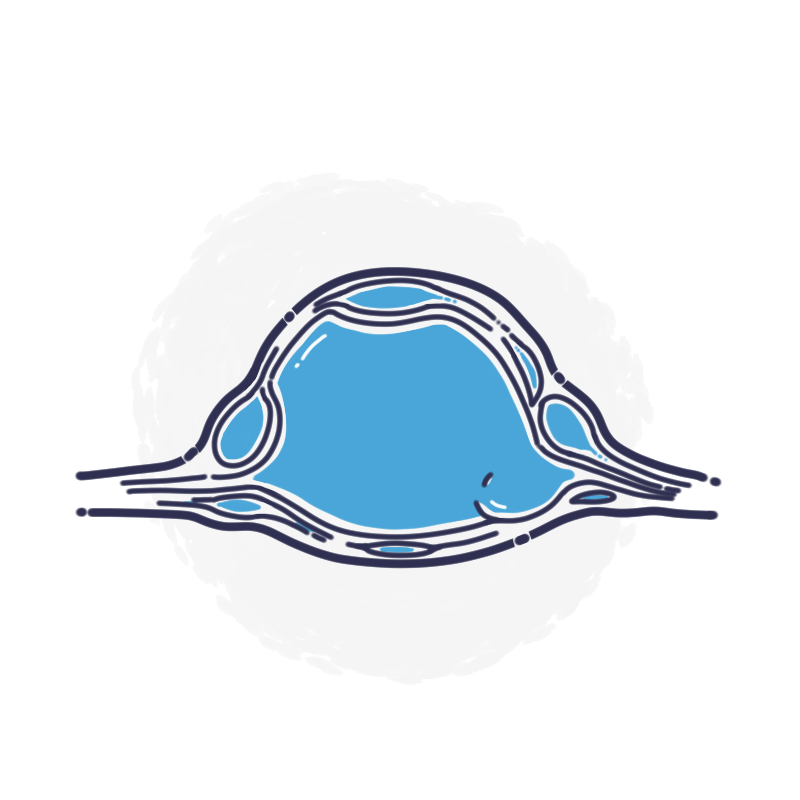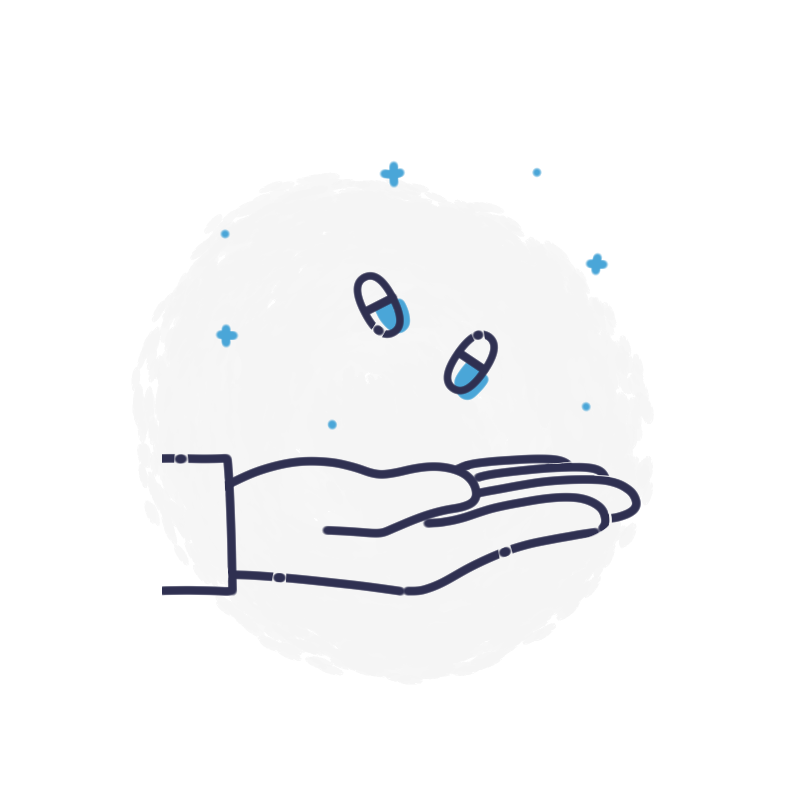ABOUT NF2-RELATED SCHWANNAMATOSIS
NF2-related schwannomatosis (NF2), formerly called neurofibromatosis type 2, is the second most common type of NF and affects approximately 1 in every 25,000 people. As with NF1, approximately 50% of people affected will have inherited it from one of their parents.
The signs and symptoms of NF2 usually develop during late teens or early adulthood, although around 10% of people with NF2 may develop symptoms earlier.
NF2 is characterised by the development of benign tumours called vestibular schwannomas (previously acoustic neuromas) on the 8th cranial nerve; the nerve that carries sound and balance information to the brain. It can result in partial or complete hearing loss and usually affects both ears.
Like NF1, it is a variable condition. Along with vestibular schwannomas, people with NF2 may also develop other benign tumours in the brain and spine. Cataracts may appear in young children and other eye abnormalities can be evident throughout life and are likely to become an issue for people with this condition.
.png)
STORIES OF NF2 HEROES
sIGNS AND SYMPTOMS
The most common first symptoms in NF2-related schwannomatosis, or NF2, are hearing and balance problems. These symptoms are due to benign tumors on the nerves leading to the ears.
NF2 is very different to NF1 in that people with NF2 do not usually have a large number of skin changes as seen in NF1. Most people with the condition will, at some point, require surgeries or other treatments for brain or spinal tumours.
Most tumours are not cancerous. It is their location and the way they impact upon nerves, tissues and organs within the body that cause the most impact on a person’s life.
Individuals with NF2 may experience a variety of symptoms, which can include:
- Headaches
- Hearing loss
- Tinnitus (ringing in the ears)
- Balance problems
- Seizures
- Swallowing and voice difficulties
- Vision loss
- Muscle weakness
- Difficulty moving around
- Nerve damage
- Pain
More detail can be viewed below:
Eyes and Vision Loss
Visual loss may be the result of damage to nerves in the brain (cranial), eye (optic), face and eye (trigeminal) and eyelid muscle nerves.
Another common visual symptom, which occurs in early childhood are juvenile cataracts (posterior subcapsular opacities). Vision impairment due to these cataracts may be experienced by some children.
It is recommended that people with NF2 monitor any changes to their vision and eye movements and routinely see an ophthalmologist.
Schwannomas
Schwannomas, as well as being seen internally, can develop in the surface or just underneath the skin. Unlike NF1, it is uncommon for people with NF2 to have more than 10 of these dermal tumours.
Most frequently these appear as a skin plaque which sits within the skin layer and is slightly raised and pigmented and often produces excess hair. Sometimes they arise as lumps underneath the skin.
Occasionally neurofibromas like those seen in NF1 are seen in people with NF2.
Skin
People with NF2 may develop a small number of café-au-lait marks, but usually less than 6 in number.

types of tumours in NF2
There are several types of non-cancerous tumours linked to NF2. The main types of tumours include:
Schwannomas
These typically non-cancerous tumours were previously referred to as acoustic neuromas. They are the result of an overgrowth of Schwann cells in the coating around the nerve (myelin sheath).
Bilateral Vestibular schwannomas are the most common sign tumour in of NF2 and are the hallmark of the condition. These tumours occur on the nerve in the brain that transmits information about hearing and balance (the 8th cranial nerve).
Schwannomas can also develop on nerves within the brain and along the spine (outside the spinal cord), and along other nerves within the body (peripheral nerves).
These tumours are categorised differently because of their location and the type of cells in the body from which they form.
Meningiomas
The meninges are membranes that surround the brain and spinal cord. A tumour can develop in cells that make up these membranes. In NF2 these are a slow-growing, non-cancerous tumours that usually develop on the surface of the brain.
Because they are slow growing, immediate treatment may often not be required. Surveillance may occur over many years before any treatment is required. When they do cause symptoms, it is because they are compressing on the adjacent brain tissue.
Treatment is generally surgery.
Gliomas
These are tumours, sometimes referred to as astrocytomas, that originate from glial cells, cells that surround neurons, providing them with structural support, in the brain and along the spine. In most cases, NF2 gliomas are low-grade, meaning they are slow-growing or benign.
Ependymomas
These are tumours that develop from cells (ependymal cells) that line the fluid-filled areas of the brain (ventricles) and the centre of the spinal cord or from radial glial cells, which are involved in early development of the brain.
DIAGNOSTIC CRITERIA
In 2022, an update to the diagnostic criteria for the genetic condition formerly referred to as neurofibromatosis type 2 (NF2) and schwannomatosis has been published in Genetics in Medicine, the official journal of the American College of Medical Genetics and Genomics (ACMG).
The diagnostic criteria for NF1 and NF2 were previously established at the National Institutes of Health (NIH) consensus meeting in 1987, and the diagnostic criteria for schwannomatosis was established in 2005. Since that time, and thanks to the work of many researchers, there has been a tremendous increase in knowledge about these genetic conditions.
The former diagnostic criteria for NF2 and schwannomatosis classified patients primarily based on clinical features, however, it is now apparent that the manifestations of these conditions span the same continuum. For this reason, "schwannomatosis" no longer defines a distinct syndrome, but is now used as an umbrella term to describe the overlapping conditions in which a patient has many schwannomas, including NF2-related schwannomatosis.
A diagnosis of NF2-related schwannomatosis can be made when a patient has one of the following:
- Bilateral vestibular schwannomas (tumors on the hearing nerves of both ears)
- An identical NF2 pathogenic variant* in at least two separate NF2-related tumours (including schwannoma, meningioma, and/or ependymoma)
- Either two Major OR one Major and two Minor criteria - as indicated in the infographic here.
Once someone has been diagnosed with NF2, a number of tests may be helpful in defining the nature and progression of the disorder. These tests include an MRI (magnetic resonance imaging) scan and an audiometry or hearing test. Often, an ophthalmological (eye) exam is also recommended. Genetic testing for NF2 can be done, which is a personal choice. It can be used to establish or confirm a diagnosis of NF2 when the situation is uncertain. A genetics healthcare provider or genetic counsellor can help you make this decision.
Management and treatment
Each person’s condition will develop differently and may change quickly. Tumours can grow or remain stable (no growth) for extended periods of time, so regular surveillance and monitoring is highly recommended for managing NF2.
Monitoring may consist of:
- Clinical examination
- MRI scans
- CT scans
- PET scans
- Hearing assessments
- Vision testing
A person with NF2 might seek out care from a number of specialists, such as:
- Neurology – treats conditions affecting the brain and spine.
- Otolaryngology (ENT) – for ear, nose, throat, and vestibular (inner-ear balance) systems.
- Ophthalmology - eyes and vision.
- Neuro-ophthalmology - visual problems related to the nervous system.
- Oncology - benign and malignant tumors.
- Pediatric medicine -for children and adolescents.
- Genetics - how genes affect a medical condition
- Neurosurgeons – surgical options for the brain and spinal cord.

treatments
Currently there is no cure for NF2; however, there are ways to manage some of the symptoms of the condition.
Medications
No medication has been discovered yet that effectively treats NF2 symptoms. However, there are some targeted drug therapies under investigation, these are aimed at reducing the size and impact of NF2-related tumours.
See Research for information about drugs under investigation.
Avastin (Bevacizumab), while still being trialled around the world, is a medication that has in some studies shown promise in reducing the size of tumours and preserving hearing in patients with vestibular schwannomas.
This drug is now available for use in NF2 in a number of countries. While Avastin is currently available in Australia on the PBS (pharmaceutical benefits scheme) for other conditions, it is used ad hoc for NF2 based upon the availability of funding through the hospital where treatment is being offered, through compassionate access or where there is an ability to self-fund. Unfortunately, the drug costs several thousands of dollars per month. The CTF is continually looking into avenues for funding.
Hearing Rehabilitation Aids/Implants
Hearing aids there are several types of hearing aids that are commonly used by people impacted by hearing loss caused by NF2. These may be an externally attached device, anchored to a bone or implanted.
Cochlear Implants can be implanted in some instances to assist with hearing rehabilitation when the hearing nerve (8th cranial nerve) is left intact after radiotherapy or surgery.
Auditory Brainstem Implants (ABI) may be used to assist hearing environmental noise, along with lip-reading, where it has not been possible to keep the hearing nerve intact. It works through stimulating the hearing pathways of the brain directly rather than the nerve. Surgery to implant these, however, is only undertaken at a select number of centres in Australia.
One of the challenges with implants is that subsequent MRI scans can become difficult as these devices have magnets in them. This will invariably cause shadowing on the images, leading to an inability to effectively monitor someone’s tumour burden and progression.
Cochlear implants may also deteriorate over time.
It is important to discuss the risks and benefits with your specialist before making any management decisions.
Surgery
Surgery is the most common treatment for NF2 associated tumours. When a tumour is impacting surrounding tissues, causing functional symptoms or is in a difficult location surgery is often considered.
There are several ways surgery can be performed, and this will depend on the location, type and size of the tumour to be removed.
Radiation Therapy
Radiation therapy does not remove tumours but is used to slow growth.
This treatment is most commonly used for treatment of vestibular schwannomas and meningiomas.
There are two ways in which radiation therapy can be used to treat vestibular schwannomas and meningiomas in NF2:
- Stereotactic Radiosurgery - providing a single high dose of radiation
- Stereotactic Radiotherapy - providing several smaller doses of radiation across several treatments.
The aim of both radiosurgery and radiotherapy is to stop tumour growth. Your radiation oncologist will provide details as to the best treatment option based on individual circumstances including tumour growth, location, size and any impingement on surrounding tissues.
Several systems have been used for delivering radiosurgery in the NF2 space. These include the gamma knife and the cyber knife (Novalis).
Radiation therapy is less responsive to tumours caused by NF2 than it is for other acoustic neuromas tumours even of the same type which are not caused by this condition.
To be most effective the tumours being treated by radiation therapy must range within certain size limits.
RESOURCES
SEE RESOURCES
Disclaimer: We have taken all reasonable steps and care to ensure that the information on this page is medically accurate and up-to-date at the time of writing. The Children's Tumour Foundation cannot be liable should this information change with new research. Please always consult your individual healthcare specialist for advice about your specific condition and needs.
.png)